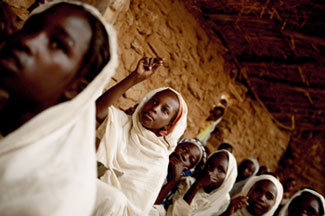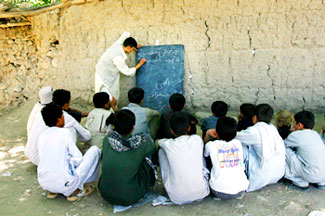JIM.LOBE

WASHINGTON (IPS/GIN) — More than 43 million children living in conflict-affected countries are not able to attend school, according to a new report that called on donor countries and multilateral agencies to commit $5.8 billion a year to address the problem.
The 48-page report, recently released here and in 39 other countries worldwide by the International Save the Children Alliance, said only 30 percent of total foreign aid earmarked for education in the world’s 63 poorest countries——the vast majority in sub-Saharan Africa and South and West Asia——went to the 30 countries affected by or emerging from regional or internal conflicts.
Among the countries with the highest percentages of non-enrollment are Afghanistan, Angola, the Democratic Republic of Congo (DRC), Cote d’Ivoire (Ivory Coast), Ethiopia, Pakistan, Sudan and Uganda, according to the report, entitled “Rewrite the Future.”
“Today the majority of victims from war are civilians, not soldiers, and those left destitute are mostly children,” said Charlie MacCormack, president of the U.S. chapter of Save the Children. “The world cannot stand by, leaving these children without education and without hope or opportunity, in some cases for generations.”
The group stressed that, without schools, children were far more susceptible to recruitment by armies and militias or other forms of exploitation.
The report was released just days before next week’s annual meeting of the International Monetary Fund (IMF) and the World Bank, which takes place this year in Singapore.
The bank, whose current lending portfolio includes $8.4 billion for education, has increased its lending for primary education in recent years as part of its Education for All Fast Track Initiative.
It also comes amid growing concern that the goal set by world leaders at the 2000 Millennium Summit of ensuring primary education is universally available by 2015 is unlikely to be met.
Some 115 million children——or almost 20 percent of the world’s primary school-aged children——are still not enrolled, according to Britain’s foreign aid agency, which estimates that donors will have to increase their spending on primary education from the current $2 billion a year to some $12 billion a year in order to close the gap.

Of the additional $10 billion a year, according to the report, $5.8 billion should be earmarked for countries affected by or recovering from violent conflicts.
Much of the assistance to these countries comes in the form of humanitarian aid, only two percent of which, according to the report, is earmarked for education.
“It is far more difficult to implement development programs in conflict areas than it is in secure areas, and too little donor funding has been devoted to educating children in conflict settings,” according to New York Rep. Nita Lowey, one of three U.S. lawmakers who participated in the report’s launch here.
Ms. Lowey, who was joined by Rep. Donald Payne of New Jersey and Diane Watson of California, is also the co-author, with New York Sen. Hillary Clinton, of the Education for All Act, which, if passed, would increase U.S. aid for basic education from $500 million to $2.5 billion by 2010.
The report details the consequences of armed conflict on education in 30 countries, 18 of which face ongoing violence. In many cases, schools have been destroyed or commandeered by armed groups or used as shelter for those who have been displaced; students have been forcibly recruited; and teachers have been killed or forced to flee due to their status as government representatives.
“Given that most conflicts last for more than 10 years, children are spending their whole childhoods living in fear and without access to education,” according to the report. It also noted that some two million children have been killed in armed conflicts during the past decade, six million more have been injured, and another 20 million displaced from their homes. And because children in conflict-affected countries are unable to start school until they are older, there is often an above-average age school population when peace is restored. After 14 years of conflict in Liberia, for example, some 60 percent of the primary pupils were over age.
The countries with the largest number of children——nearly eight million in each——out of primary school are Nigeria and Pakistan, both of which have been affected by internal and external conflicts in recent years. Nearly six million children in Ethiopia are out of school, although the report noted that the government in Addis Ababa has devoted increasing resources to primary education since the 1999 war with Eritrea.
In the DRC, which despite recent elections continues to be ravaged by local conflicts, more than five million primary-aged children are not receiving an education.
Nearly 2.5 million children are out of school in the Sudan, which ended a 23-year-old civil war with its southern population only last year. At the same time, less than 40 percent of primary-aged children are enrolled in school in Darfur, its westernmost region, due to violence that has displaced more than two million people and killed as many as 450,000. In neighboring Chad, more than 40 percent of primary-aged children are out of school.
Outside of sub-Saharan Africa and South and West Asia, the conflict-ravaged countries with the greatest enrollment problems include Haiti and Colombia, which each have around half a million primary-aged children who are not in school; Burma/Myanmar, with nearly one million absentees; and Iraq, where some 800,000 children are not receiving an education.












